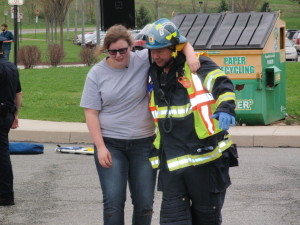D.A. wishes every high school would present similar program
By Kathleen Brady, Managing Editor, The Times
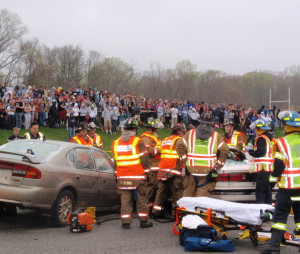
As the Rustin High student body watches, first-responders work to extricate the students trapped in the vehicle during the mock crash exercise.
The two blood-splattered Bayard Rustin High student drivers managed to crawl from the wreckage of their two-car crash behind the school, but several passengers were trapped; later, two of the teens would leave in body bags and another in handcuffs.
Fortunately, the carnage was staged, but its reality looms large enough as prom season approaches that the Rustin High School Parent Teacher Organization (PTO) sponsored a potent, three-pronged program on Friday designed to deter impaired driving. The group received substantial support , ranging from the school district to local first-responders to county agencies.
Chester County District Attorney Tom Hogan said similar programs are being held throughout the county, but he wished every school district would participate. “This is something they really should do every year,” he said.
First, the student body watched uncomfortably from behind yellow police tape as the dramatic depiction unfolded. Fighting hysteria, one of the teen drivers called 9-1-1. Within minutes, the wail of sirens preceded the arrival of about 30 first responders.

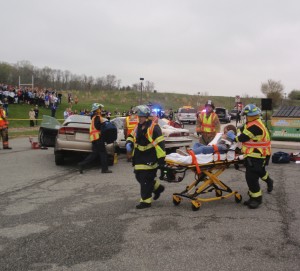
First-responders wheel one of the injured teens to a waiting ambulance during the simulated exercise.
As firefighters used chainsaws to try and extricate the passengers, a Westtown-East Goshen police officer smelled alcohol on the breath of one of the drivers and began questioning her. Then parents began to arrive, including the mother of one of the students who wouldn’t survive; she had to be restrained by police.
The impaired driver failed field sobriety tests and registered a 0.16 blood-alcohol content. As she was taken into custody, firefighters removed the roof of one of the vehicles. A soft, steady rain began to fall, but with the exception of covering the sound equipment and covering some heads with hoods, neither the participants nor the hundreds of spectators reacted to it.
Instead, the focus remained on the tragic tableau, which concluded with the loading of two body bags into the coroner’s van. It arrived after paramedics pronounced two of the victims dead at the scene. Then Corey J. Fields, a Rustin assistant principal, led the students into the auditorium for the second and third parts of the program.“We hope that you never have to go through what you just saw,” he said.
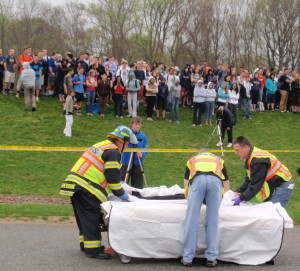
Workers from the Chester County Coroner’s Office get ready to place one of the teens pronounced dead at the scene into a body bag.
But Fields and other organizers know that statistics do not make those odds favorable – a reason to continue to remind students to be mindful of the dangers and avoid them. “I’m here to talk to you about what happens next,” Hogan told the young audience. He then enlisted two male volunteers, who sat side by side on the stage.
One had driven drunk and killed his friend, Hogan explained. “Turn your chair around. You’re dead,” he told one of the teens. The other would become a victim, too, Hogan said, describing how his life would become “a living hell.” He would be unable to attend his friend’s funeral because the family wouldn’t want him there. If he had planned to go to college, his acceptance would likely be rescinded, which would be a good outcome financially since a defense attorney would cost his family at least $50,000.
Being found not guilty would be virtually impossible, Hogan said. “Our jurors hate people who get into a crash driving drunk,” he said. The mandatory maximum three-sentence for homicide by vehicle while DUI would ensure a state prison term with rapists, murderers and gang members, Hogan said. “You’re living in fear every single day, and when you get out, you’re damaged goods. You won’t be hired anywhere.”
Hogan urged the students not to fall into what has become a heart-breaking pattern. “The choice is yours,” he said, adding that he wanted to avoid responding to a crash, “where at the end of the night I have to wipe blood off the bottom of my shoes.”
He was followed by Sharine Davis, the community outreach manager at Bryn Mawr Rehab Hospital, which runs “Cruisin’ Not Boozin,’” an award-winning program that brings young adults face-to-face with the devastating consequences of distracted or impaired driving. It features first-hand accounts from survivors of motor-vehicle accidents that resulted from distracted or impaired driving.
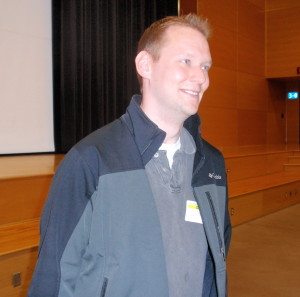
Chris Weersing, 29, of West Chester, calls talking to teens about the danger of impaired driving “my therapy.”
Davis introduced Chris Weersing, 29, of West Chester, who would rivet the crowd with his candid, poignant testimony about avoiding the mistakes he made. He said ruefully that he shared the common teen mentality that catastrophe is “never going to happen to me.”
Instead, he was a victim multiple times of bad decisions, he said. After a skiing accident ruined his sports career, he increased his alcohol intake to become “the life of the party,” a habit that escalated into drug abuse.
On Aug. 7, 2005, he attended a college graduation party, and after drinking, he saw a friend wisely leave on foot, and he and a buddy unwisely chased him down in Weersing’s truck, picked him up, and drove him home. He learned much later that the friend hadn’t even gotten into his house when he heard the crash.
“The road turned, and I did not,” Weersing said. He slammed into a tree, breaking his neck in two places and falling into a coma that doctors did not think he would survive. His passenger walked away from the collision, but Weersing spent 10 days in a coma and 16 weeks with a neck brace, he said.
Although his recovery was painstaking and miraculous, permanent damage persisted, and Weersing said he had to abandon his lifelong dream of becoming a high school history teacher. The emotional toll was heavy, he said. “Every single flippin’ morning you have to look at the person who ruined your life,” he said.
Still, his rehab was not complete. He continued to drink even though he had been warned it could trigger a seizure. A night of heavy alcohol consumption on May 17, 2006, prompted an ultimatum from his parents, who had been at his side every step of the way, he said.
His father, a firefighter, had responded to his accident scene, where he was transported to Crozer Regional Trauma Center. His mother, a nurse there, never left his bedside. “I only quit [drinking] because they made me,” he said.
Speaking to high-school students serves as therapy, he said. “I’m hoping and praying one of you hears me today,” he said. I’m extremely jealous of you guys. You have a choice.”
Weersing ended by asking the students what he should have done differently the fateful day he got behind the wheel drunk. “Nothing is the correct answer,” he said. “I was spiraling out of control.” Now, he’s taking courses at Villanova to become a drug and alcohol counselor, he said.
Kelsey Pryze, 17, of West Chester, a junior at Rustin, said she was very impressed with the program. “The mock crash was pretty horrific,” she said. “It really captured your attention.” Pryze said she also thought both speakers did an excellent job of personalizing the presentations.
Marissa Vaul, 16, of West Chester, agreed. Vaul, a member of Students Against Drunk Driving, said the program was shocking in a productive way. “It made a good impression,” she said.
Fields said the program cost about $2,000, which was donated by the Westtown-East Goshen Police Association. He expressed gratitude to the myriad agencies that assisted, including the Goshen Fire Company/Ambulance/ Fire Police, Medic 91, and Abel Brother’s towing.
Hogan called the cost minimal when compared with the expense for medical intervention, funeral arrangements, prosecution and imprisonment. “It was definitely worth it,” he said.
Westtown-East Goshen Regional Police Chief Brenda Bernot said she was extremely pleased with the outcome of the program as well as the students’ reaction. “We can’t save everyone,” she said. “But we’re hoping that some of these kids were listening and that we made a difference.”


